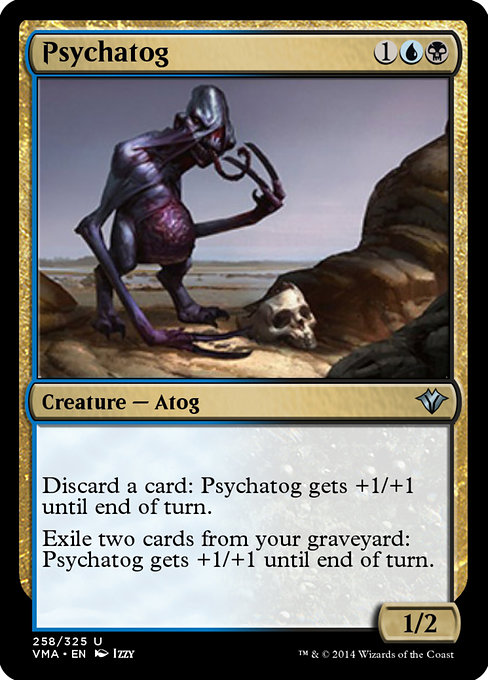
Image courtesy of Scryfall.com
Psychatog’s Influence on Legacy Metagame Trends
In the annals of Legacy, some cards become more than just numbers on a card; they become engines that bend the metagame around their cudgel-wielding unpredictability. Psychatog, a blue-black ATog with a hunger that could be sated by the right mix of cards, is one such example. Its mana cost (1U B) and a compact body belied a potential for explosive swings that forced players to rethink how they built stalls, draw engines, and removal thresholds. This little three-mana creature could flip the script on control-heavy games and tilt the balance toward midrange inevitability. 🧙🔥💎
A quick look at the creature and its two-pump dance
- Discard a card: This creature gets +1/+1 until end of turn. A single card becomes a catalyst for a sudden tempo swing, turning a modest body into a threat that must be answered immediately.
- Exile two cards from your graveyard: This creature gets +1/+1 until end of turn. The second trigger rewards graveyard management—both filling your own graveyard with potential fuel and pruning your opponent’s resources by denying them recurrences.
What makes Psychatog so intriguing is not just the raw pump numbers but the timing of those pumps. The card invites a careful dance: you weigh the value of discarding a card from your hand versus leveraging the graveyard as a reservoir of fuel. When you pull off a well-timed pair of pumps, you’re looking at a swing that can close a game before the opponent finishes resolving a threat of their own. This is where Legacy decks learned to respect the psychology of tempo: the threat of a sudden, unstoppable push can force opponents into suboptimal blocks or premature removal. 🪄
The metagame dynamics: how this card nudged decks toward resilience and resourcefulness
Psychatog sat at the crossroads of disruption, card advantage, and graveyard interaction. In Legacy, blue and black have long venerated the art of card draw, countermagic, and graveyard interplay, and Psychatog provided a high-impact finisher that rewarded a well-tuned engine. The presence of a card that can grow with scarce resources while leveraging graveyard contents created a niche where players experimented with: - Graveyard-centric shells: Decks built around filling the graveyard with cheap discard outlets and ways to exile cards, so Psychatog could flip power on a single turn. From a strategic standpoint, this encouraged a broader suite of graveyard manipulation tools in Legacy from tutors to thought-kickers, all feeding the creature’s pump window. 🧠🎯 - Counterbalance between pressure and protection: Blue-black lists leaned into permission and disruption to keep cycles going, while Psychatog loomed as the edge-case finisher that could obliterate life totals with a few efficient plays. The pressure was not just about landing a big attack; it was about forcing your opponent into a reaction that would open the door for a lethal follow-up. ⚔️ - Graveyard hate as a frontline response: The deck’s existence made graveyard hate not merely a sidebar but a central lane of the metagame. Against Tog, players leaned on cards that can stifle the graveyard’s utility or punish repeated copies of the pump—removing a threat before it grows too large remains a timeless theme in Legacy. 🧪
“Power isn’t always a measured curve; sometimes it’s a spark that turns a handful of cards into a volcano.”
And then there’s the supply chain of card advantage. While Psychatog itself thrives on efficient free-form growth, it’s the ecosystem around it—Brainstorm, draw spells, cantrips, and selective discard—that keeps the engine humming. In Legacy, where the pace is often dictated by who can resolve threats first and protect them longest, a well-timed toggling of power can decide a match in a single, decisive swing. That’s why Psychatog became less about a one-card miracle and more about a philosophy: manage resources, maximize your graveyard, and let a small, relentless creature become an unstoppable finisher. 🧙♂️💥
Design notes, art, and the collector’s gaze
Izzy’s art on Psychatog—paired with the Vintage Masters reprint—carries a certain district of nostalgia that resonates with long-time players and new collectors alike. The card’s uncommon rarity in that set, combined with its foil and nonfoil variants, gives it a unique place in a collector’s binder. For some, the card’s holographic shine is a reminder of the era when blue-black control and midrange strategies ruled the Legacy landscape, and a reminder that a single creature could catalyze a meta shift. The card’s EDHREC rank (a reference point for casual commander players) sits far from the top, underscoring its Legacy-centric legacy but also its crossover appeal among players who appreciate the deckbuilding challenges it presents. 🎨🗂️
From the table to the display case: value, accessibility, and cultural footprint
Psychatog’s journey from a tournament staple to a beloved relic underscores a larger truth about MTG design: small card-advantage engines can leave outsized imprints on a format. While modern formats drift toward new mechanics and unfamiliar combos, the legacy-era Tog reminds us of a time when players learned to wring every advantage from a compact blueprint. The card’s interplay between discard, graveyard exile, and a two-pronged pump approach is a microcosm of the larger design ethos that Magic’s most enduring archetypes represent: resourcefulness, timing, and a touch of luck in the draw. 🧲🎲
Whether you’re chasing the nostalgia of a bygone Legacy era or exploring how modern risk-versus-reward decisions echo those classic plays, Psychatog’s influence remains a testament to how a single, well-timed burst of power can redefine a metagame. And if you’re streaming through sessions or bunkering down for a long drafting or deck-building session, a little comfort goes a long way—hence the cross-promotional note below about a certain ergonomic mouse pad that keeps your wrists happy as you map out your next Tog-powered line. ⏳💎